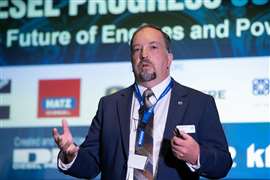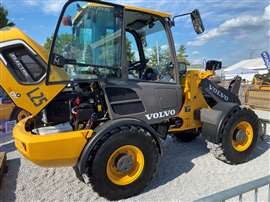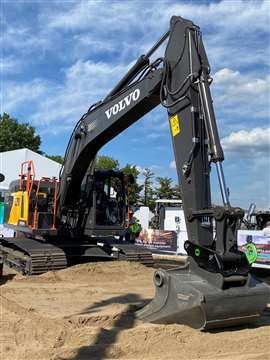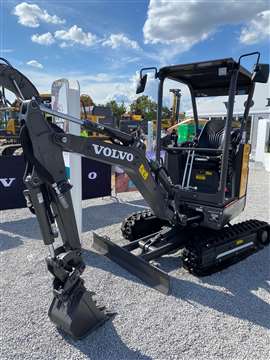Interview: Volvo CE’s Ray Gallant on the challenges of decarbonising construction equipment
30 October 2023
International Rental News’ (IRN) Murray Pollok talks to Ray Gallant, Volvo CE’s vice president for sustainability and productivity services, about the energy transition and construction machines.
A conversation with Ray Gallant of Volvo Construction Equipment opens the eyes to the complexities of the energy transition for equipment manufacturers.
For one thing, there is the scale of the challenge in developing low-carbon versions of traditional machines. Volvo CE, which remember is a front-runner in developing electric machines, currently has battery powered versions of just seven of the 32 machines it makes in the 32 tonnes and under segment.
 Ray Gallant, Volvo CE’s vice president for sustainability and productivity services. (Photo: KHL/Melissa Jacobs)
Ray Gallant, Volvo CE’s vice president for sustainability and productivity services. (Photo: KHL/Melissa Jacobs)
And then consider that the OEM’s full product line-up comprises more than 200 models, with low or zero carbon versions of these requiring battery powered machines as well as hybrid and hydrogen powered models (fuel cell or combustion). There will also be the use of “bridge” technologies such as renewable diesels and HVO (hydrotreated vegetable oil) fuel.
Gallant, a 12-year veteran of product development and sales support at Volvo CE, tells IRN that beyond the R&D and manufacturing challenge, it is the charging infrastructure for electric machines that is an immediate issue, particularly for rental companies starting to invest in electric.
“One electric machine is fairly easy to run,” says Gallant, “but if it is two or three machines, the charging infrastructure becomes more important.”
At the recent Utility Expo in Louisville, for example, Volvo CE was partnering on its booth with Sunbelt Rentals, which provided a battery energy storage unit to charge the electric machines on the stand.
“We’re working on a charging solution in the US for early next year,” says Gallant, adding that Volvo will also have to use what is available on the market. (Separately, Volvo CE’s sister company, Volvo Penta, has invested in US company Utility Innovation Group (UIG), which is developing containerised battery energy storage systems (BESS) that could be applicable in the construction equipment market.)
 Volvo CE’s L25 electric wheeled loader, pictured at the 2023 Utility Expo in Lousiville. (Photo: IRN)
Volvo CE’s L25 electric wheeled loader, pictured at the 2023 Utility Expo in Lousiville. (Photo: IRN)
Charging options
There will be two charging options: AC charging, typically for overnight use, and faster DC charging (such as a battery storage system), which could be sized up to 350kW, 750kW or 1MW.
“The charging strategy depends on what power you have, the duty cycle, the number of machines,” says Gallant. “There will be a whole business around the strategy for renting and operating electric machines on site.”
He says it will not be efficient to have one charger on site for one machine - “You never want to buy it that way” - and far better to have a charging unit working with multiple machines.
“Figuring out that charging network will be important. That’s a massive change in thinking and habits, and I think this is a good opportunity for us to think that through with customers.
“We’re starting to have these conversations with rental companies,” says Gallant. He adds that Sunbelt Rentals is one example of a major renter company taking a lead on the issue.
He views rental companies, generally, as being cautious about the technology; “Very few people say the transition won’t happen, but there are thousands of opinions about how quickly or how much.”
Which applications?
On the question of where electrification will work best, he says the sweet spot will be applications with shorter duty cycles and lower power, with fuel cell and hydrogen combustion required for longer duties and higher power applications.
“There are applications where electrics are better suited,” he says, “and a lot of companies want to rent machines to try them out. That’s a big part of the market right now.”
In the future it will become about special applications, such as working with livestock or in urban areas, where noise is a big consideration; “Just trying to replicate a straight diesel machine on a job - there’s not that much of an advantage.”
On one thing he is very clear: “The trick with electric machines is to put the hours on it; that’s where you get payback.”
2nd generation electrics
There is also the question of the design of the electric models themselves. The current range is what could be called first generation electric: electric “conversions” of diesel machines, using hydraulic components.
He says second and third generation battery powered models will be designed as fully electric, something that for the time being would be costly for machines that are already more expensive than diesel powered units.
 Volvo’s EC230 electric excavator uses a 264kWh capacity battery, with a battery voltage of 600V. (Photo: IRN)
Volvo’s EC230 electric excavator uses a 264kWh capacity battery, with a battery voltage of 600V. (Photo: IRN)
“New models are being developed,” says Gallant, “and eventually we will see them designed as electric from the ground up, with no diesel option.”
Looking at other power options, he says hydrogen combustion and hydrogen fuel cells will be coming. “The real advantage of hydrogen will be for high power, long duty cycle applications. For shorter duty, lower power, it will be batteries.”
He says the advantage of hydrogen is that it offers the prospect of a lot of power and quick refueling; “The disadvantage is that it takes a lot of energy to produce and store hydrogen, and you need an infrastructure.
“It is also efficient weight-wise, but ineffective volume-wise [hydrogen takes up a lot more space than diesel]. These are challenges that we have to work out.”
Fuel storage challenge
He thinks we will start to see machines designed around fuel storage, perhaps with multiple, smaller tanks. That is partly because small tanks will be necessary to maintain hydrogen at the required pressure.
IRN asks about fuel cells; will they be robust enough for construction applications? “I don’t think they are ready yet, but we are very close,” he says. “We are still concerned about vibrations and the conditions on site, but we’re getting to the point where it’s technically feasible.”
Gallant also thinks that, although there is a lot of focus on developing zero emission machines, quicker progress on reducing carbon emissions can be made using bridge technologies such as lower-carbon fuels like HVO and renewable diesels. He also points out that there will be opportunities for the electrification of attachments.
And of course, there is a global fleet of millions of diesel-powered machines already out there. “I do foresee having retrofit kits to convert diesel to battery machines.”
That’s another complexity on the road to clean construction equipment.
 The Volvo CE ECR18 short tail radius electric excavator. One of the OEM’s seven small electric models. (Photo: IRN) The Volvo CE ECR18 short tail radius electric excavator. One of the OEM’s seven small electric models. (Photo: IRN)
BOX STORY Volvo Construction Equipment’s current range of seven battery powered models comprises two compact wheeled loaders (the L20 and L25), three mini excavators (the ECR18 and ECR25 short swing models and the EC18) and the 23 tonne EC230 Electric. The latter was launched earlier this year in Europe, and it was shown at ConExpo in March (and at the Utility Expo). The most recent electric launch is the DD25 compaction roller, which is just now going into production at Volvo’s factory in Shippensburg, USA. All seven of these are also available as conventionally powered machines. The EC230 uses a 600V supply - provided by four battery packs each providing 66kWhr - while the smaller machines use a 48V supply. |
STAY CONNECTED




Receive the information you need when you need it through our world-leading magazines, newsletters and daily briefings.
POWER SOURCING GUIDE
The trusted reference and buyer’s guide for 83 years
The original “desktop search engine,” guiding nearly 10,000 users in more than 90 countries it is the primary reference for specifications and details on all the components that go into engine systems.
Visit Now
CONNECT WITH THE TEAM










